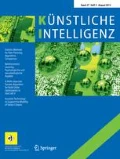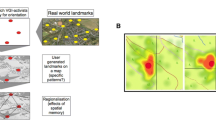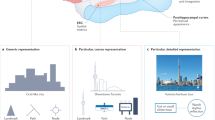Abstract
In this discussion essay, I contend that the role of landmarks is exaggerated in basic and applied spatial cognition research. Specifically, I discuss empirical and theoretical arguments consistent with two claims. First, the word landmark is a label for several different concepts, although its precise reference in a particular context is rarely specified carefully. Further, whether specified or not, researchers never use the term landmark to mean everything that the concept can legitimately mean. Thus, when researchers assert something about the role of landmarks in spatial cognitive activities, they exaggerate their particular meaning at the expense of a broader ontology. Second, I claim that even when landmarks are clearly and precisely defined, their role in specifying location is misunderstood and less fundamental than proposed. In exaggerating landmarks, other important components of spatial knowledge, memory, and reasoning are undervalued. Taken together, these two claims support my contention that landmarks are exaggerated in spatial cognition.
Similar content being viewed by others
Notes
They must be remembered as a specific token, not just a type. Not “a house” but “Leila’s House” (if there are no other houses around, a house becomes a token object).
Of course, the physical object that materially instantiates a sign can function as a landmark instead of a semiotic artifact—“go past the metal pole holding the red six-sided object”.
Formally defined geometric terms like “metric” do not strictly describe human spatial knowledge, as violations of the metric axioms, etc., are easily demonstrated. I use the term informally to suggest that humans display considerably more spatial knowledge than just nonmetric properties like connectivity and sequence.
References
Allen GL, Kirasic KC, Siegel AW, Herman JF (1979) Developmental issues in cognitive mapping: the selection and utilization of environmental landmarks. Child Dev 56:1062–1070
Appleyard D, Lynch K, Myer JR (1964) The view from the road. MIT Press, Cambridge
Arthur P, Passini R (1992) Wayfinding: people, signs, and architecture. McGraw-Hill Ryerson, Toronto
Benedikt M, Burnham CA (1985) Perceiving architectural space: from optic arrays to isovists. In: Warren WH, Shaw RE (eds) Persistence and change, Proc First Inter Conf Event Perc. Lawrence Erlbaum, Hillsdale, pp 103–114
Burnett G (2000) ‘Turn right at the traffic lights’: the requirement for landmarks in vehicle navigation systems. J Navig 53:499–510
Cheng K (1986) A purely geometric module in the rat’s spatial representation. Cognition 23:149–178
Collett TS (1996) Insect navigation en route to the goal: multiple strategies for the use of landmarks. J Exp Bio 199:227–235
Cornell EH, Heth CD, Broda LS (1989) Children’s wayfinding: response to instructions to use environmental landmarks. Dev Psychol 25:755–764
Couclelis H, Golledge RG, Gale N, Tobler W (1987) Exploring the anchor-point hypothesis of spatial cognition. J Environ Psychol 7:99–122
Denis M, Michon P-E, Tom A (2007) Assisting pedestrian wayfinding in urban settings: why references to landmarks are crucial in direction-giving. In: Allen GL (ed) Applied spatial cognition: from research to cognitive technology. Lawrence Erlbaum, Hillsdale, pp 25–51
Duckham M, Winter S, Robinson M (2010) Including landmarks in routing instructions. J Locat Based Serv 4:28–52
Dyer FC, Gould JL (1983) Honey bee navigation. Am Sci 71:587–597
Foo P, Warren WH, Duchon A, Tarr MJ (2005) Do humans integrate routes into a cognitive map? Map- versus landmark-based navigation of novel shortcuts. J Exp Psychol Learn Mem Cognit 31:195–215
Gallistel CR (1990) The organization of learning. MIT Press, Cambridge
Gibson JJ (1950) The perception of the visual world. Houghton Mifflin, Boston
Gibson JJ (1966) The senses considered as perceptual systems. Houghton Mifflin, Boston
Gibson JJ (1979) The ecological approach to visual perception. Houghton Mifflin, Boston
Gladwin T (1970) East is a big bird. Harvard University, Cambridge
Golledge RG (1999) Human wayfinding and cognitive maps. In: Golledge RG (ed) Wayfinding behavior: cognitive mapping and other spatial processes. Johns Hopkins Press, Baltimore, pp 5–45
Hermer L, Spelke E (1996) Modularity and development: the case of spatial reorientation. Cognition 61:195–232
Hirtle SC (2011) Geographical design: spatial cognition and geographical information science. Morgan & Claypool, San Rafael
Ishikawa T, Montello DR (2006) Spatial knowledge acquisition from direct experience in the environment: individual differences in the development of metric knowledge and the integration of separately learned places. Cognit Psychol 52:93–129
Ittelson WH (1973) Environment perception and contemporary perceptual theory. In: Ittelson WH (ed) Environment and cognition. Seminar, New York, pp 1–19
Kuipers B (2000) The spatial semantic hierarchy. Artif Intell 119:191–233
Kuipers B, Tecuci DG, Stankiewicz BJ (2003) The skeleton in the cognitive map: a computational and empirical exploration. Environ Behav 35:81–106
Lynch K (1960) The image of the city. MIT Press, Cambridge
Mark DM, Freksa C, Hirtle SC, Lloyd R, Tversky B (1999) Cognitive models of geographical space. Int J Geogr Inf Sci 13:747–774
Miller J, Carlson L (2011) Selecting landmarks in novel environments. Psychon Bull Rev 18:184–191
Montello DR (1998) A new framework for understanding the acquisition of spatial knowledge in large-scale environments. In: Egenhofer MJ, Golledge RG (eds) Spatial and temporal reasoning in geographic information systems. Oxford University, New York, pp 143–154
Montello DR, Raubal M (2012) Functions and applications of spatial cognition. In: Waller D, Nadel L (eds) Handbook of spatial cognition. American Psychological Association, Washington DC, pp 249–264
Presson CC, Montello DR (1988) Points of reference in spatial cognition: stalking the elusive landmark. Br J Dev Psychol 6:378–381
Raubal M, Winter S (2002) Enriching wayfinding instructions with local landmarks. In: Egenhofer MJ, Mark DM (eds) Geog Infor Sci, Second Inter Conf GISci 2002, Lect Notes Comp Sci 2478. Springer, Berlin, pp 243–259
Richter K-F, Winter S (2014) Landmarks: GIScience for intelligent services. Springer, Berlin
Sadalla EK, Burroughs WJ, Staplin LJ (1980) Reference points in spatial cognition. J Exp Psychol Hum Learn Mem 6:516–528
Siegel AW, White SH (1975) The development of spatial representations of large-scale environments. In: Reese HW (ed) Advances in child development and behavior, vol 10. Academic, New York, pp 9–55
Sorrows ME, Hirtle SC (1999) The nature of landmarks for real and electronic spaces. In: Freksa C, Mark DM (eds) Spatial information theory. Springer, Berlin, pp 37–50
Steck SD, Mallot HA (2000) The role of global and local landmarks in virtual environment navigation. Presence Teleoper Virtual Environ 9:69–83
Tolman EC (1948) Cognitive maps in rats and men. Psychol Rev 55:189–208
Trowbridge CC (1913) On fundamental methods of orientation and “imaginary maps”. Science 38:888–897
Yeap WK, Jefferies ME (1999) Computing a representation of the local environment. Artif Intell 107:265–301
Acknowledgements
An earlier version of this essay was originally given as an oral presentation on July 5, 2010, at the international meeting “Las Navas 2010: Cognitive and Linguistic Aspects of Geographic Space”, held at Las Navas del Marques, Avila, Spain.
Author information
Authors and Affiliations
Corresponding author
Rights and permissions
About this article
Cite this article
Montello, D.R. Landmarks are Exaggerated. Künstl Intell 31, 193–197 (2017). https://doi.org/10.1007/s13218-016-0473-5
Published:
Issue Date:
DOI: https://doi.org/10.1007/s13218-016-0473-5




